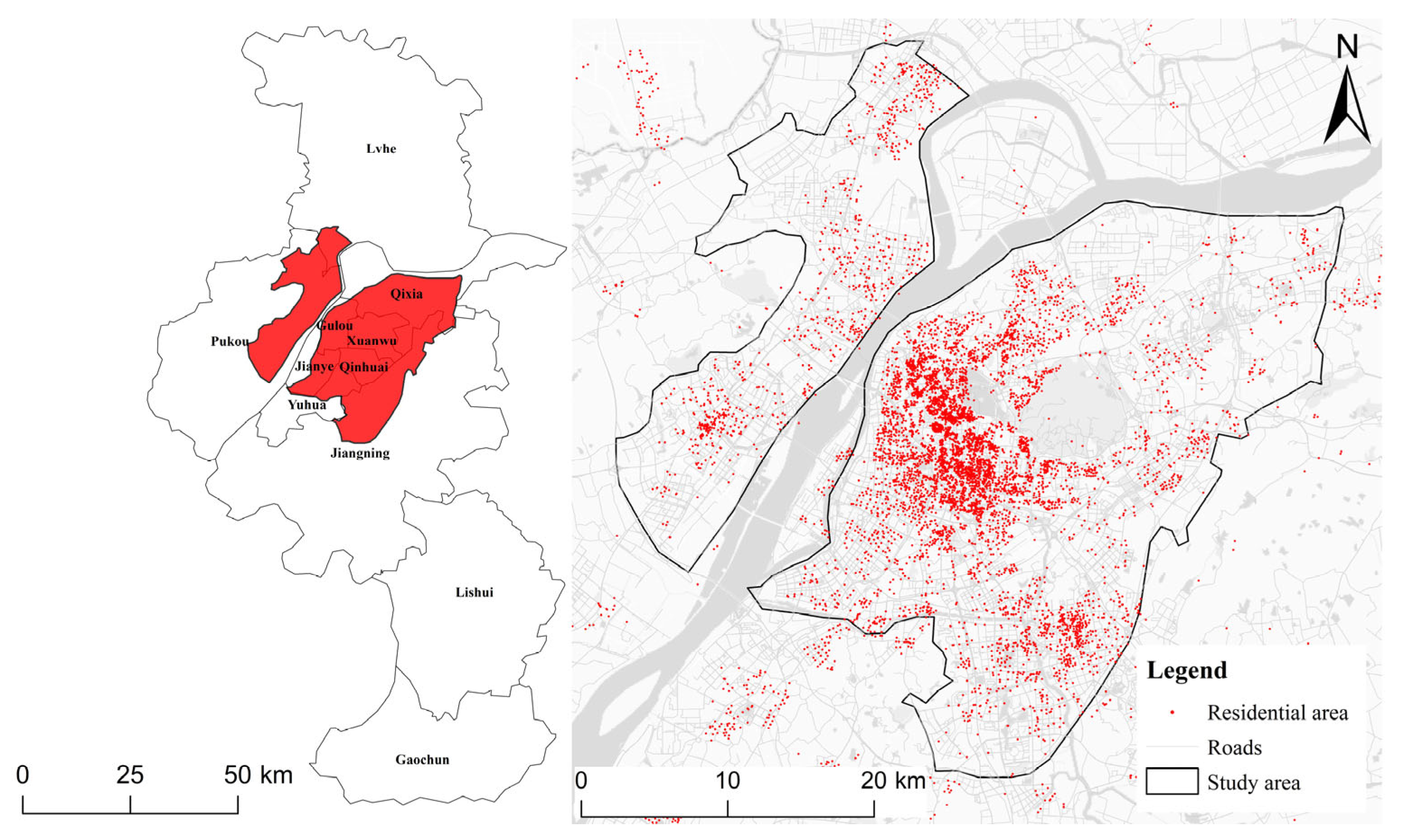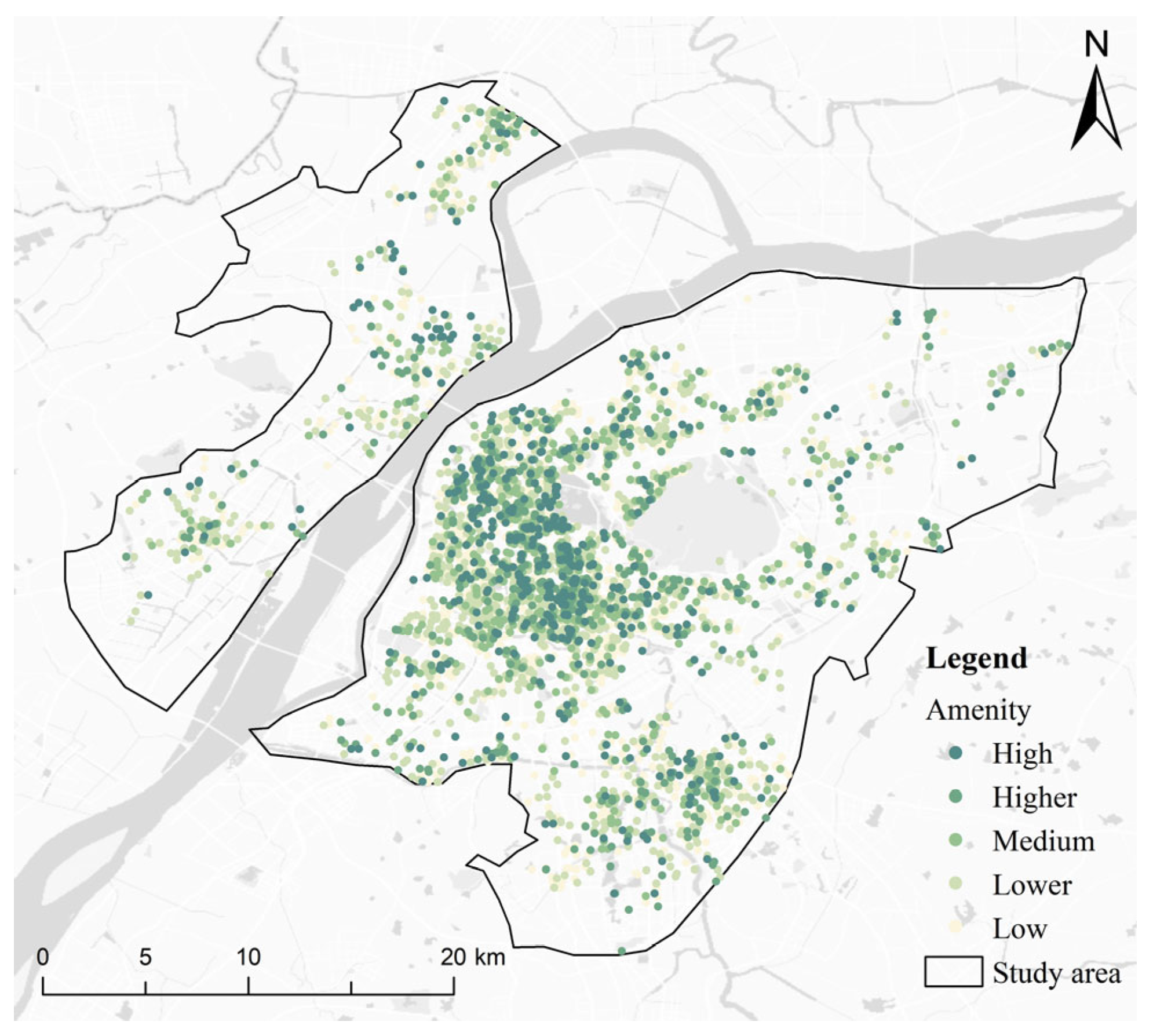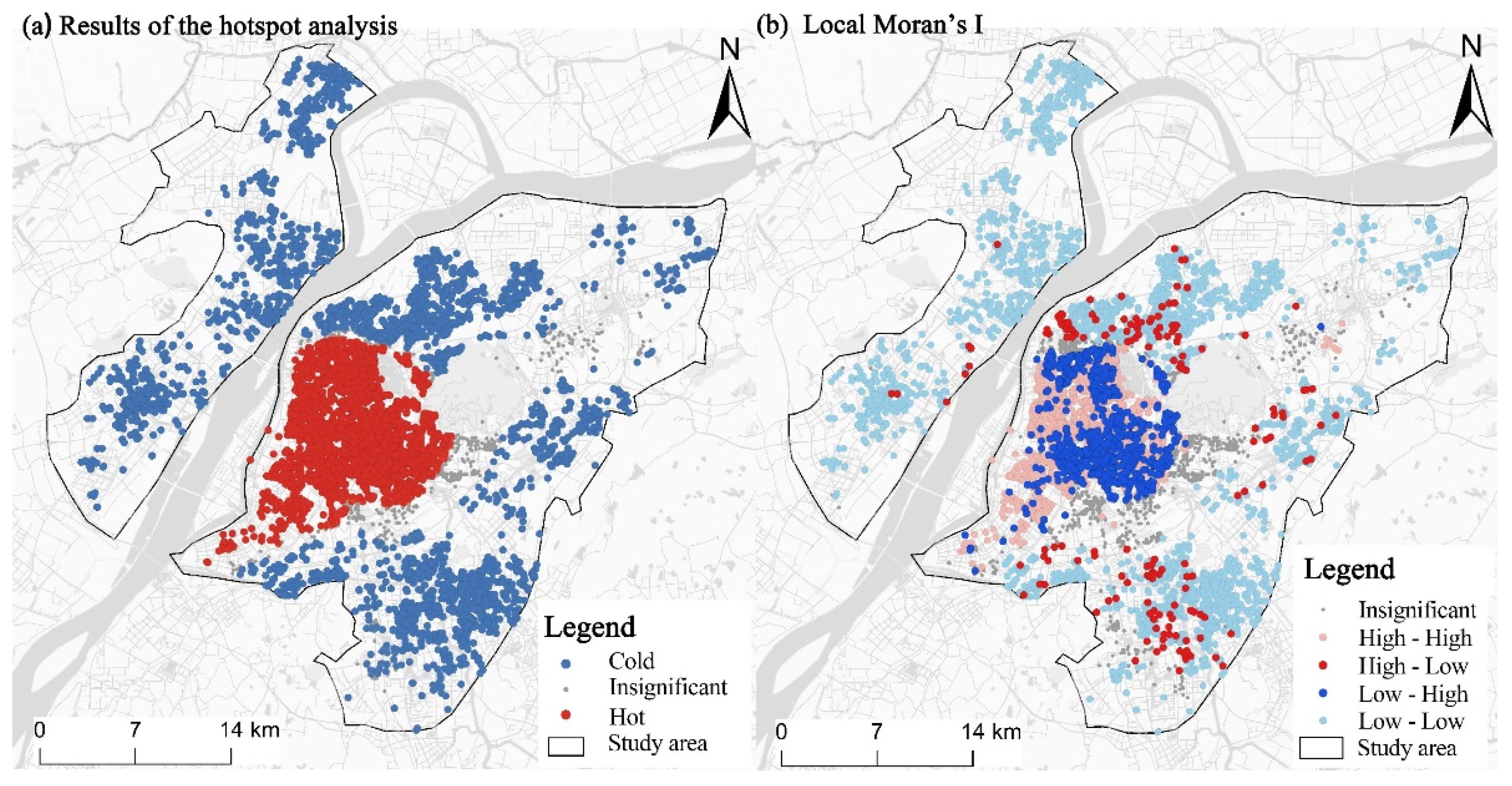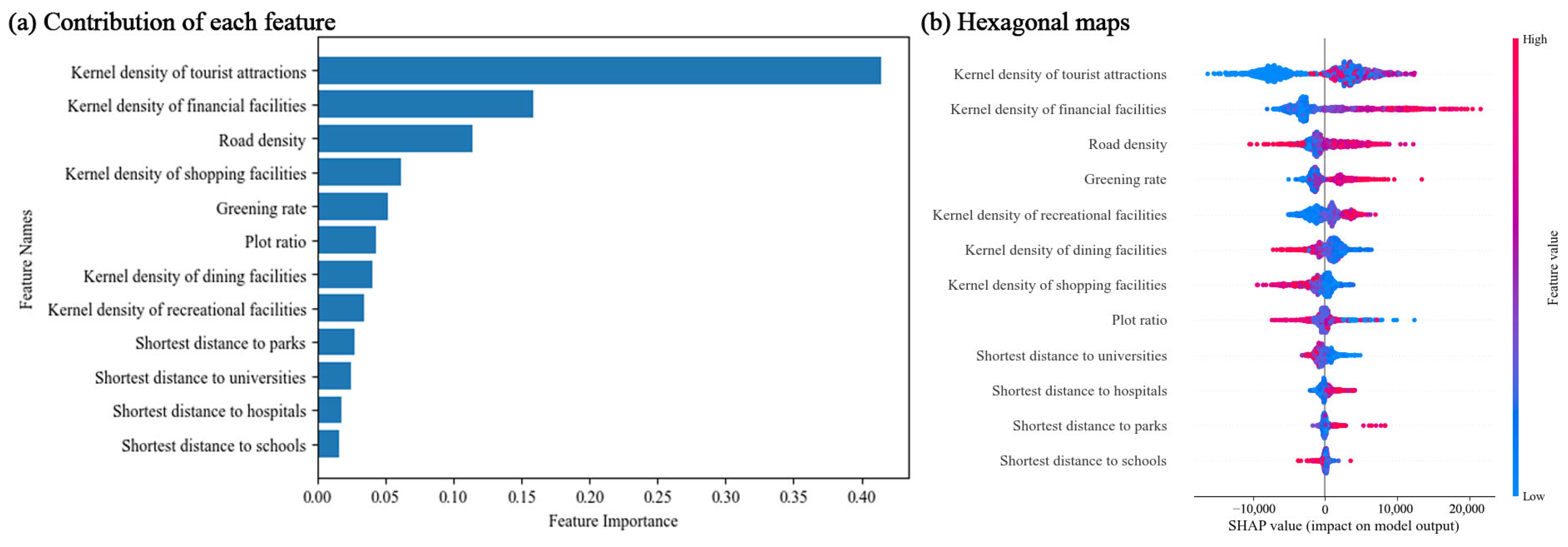Spatial Differentiation Mechanism of Urban Housing Prices from the Perspective of Amenity: A Case Study of Nanjing
Abstract
1. Introduction
2. Materials and Methods
2.1. Study Area
2.2. Data Sources
2.3. Methods
2.3.1. Local Moran’s I
2.3.2. Kernel Density Analysis
2.3.3. Gradient Boosting Decision Tree
2.4. Evaluation Indicator System for Urban Amenity
- (1)
- Natural amenity reflects the liveability of the natural environment in the city and serves as a key environmental factor influencing housing prices in cities [5].
- (2)
- Artificial amenity reflects the level of basic public services in the study area, such as education, health care, shopping, and recreation. It represents the aspect of urban amenity most highly valued by Chinese residents [18].
- (3)
- Social atmosphere amenity represents the psychological comfort derived from the social and cultural atmosphere of the city, which includes aspects such as social inclusivity and cultural diversity. As the amenity of the social environment is difficult to measure directly, this study uses the presence of universities and research institutions—representing areas with a strong atmosphere of diversity and inclusiveness—as a proxy to reflect the cultural environment of different urban areas [22], thereby assessing social atmosphere amenity.
3. Spatial Differentiation of Amenity and Housing Prices in Nanjing
3.1. Evaluation of Human Environment Amenity in Nanjing
3.2. Spatial Differentiation of Housing Prices in Nanjing
4. Spatial Differentiation Mechanism of Urban Housing Prices
4.1. Housing Price Influencing Factors
- (1)
- Areas with lower kernel densities of tourist attractions universally show lower housing prices, while areas with higher housing prices have a comparatively smaller number of tourist attractions. This finding suggests that tourist attractions have a notable impact on housing prices, but only partially explain the housing price divergence within a certain region due to the highly heterogeneous spatial distribution of tourist attraction elements.
- (2)
- The kernel densities of financial facilities, recreational facilities, shopping facilities, and road network density all exhibit a positive correlation with housing prices. This indicates that housing prices are generally higher in areas with better artificial amenity, which suggests that refinement of living service facilities would have an obvious enhancement effect on housing prices.
- (3)
- The shortest distance to hospitals is negatively correlated with housing prices. This may be due to the fact that medical visits are not a routine requirement for most residents, and that traffic congestion around hospitals is typically high; therefore, most residents do not prefer purchasing their property in a community that is close to a hospital.
- (4)
- The community green space ratio shows a positive correlation with housing prices, but a negative correlation with the shortest distance to parks. This reflects that residents are more concerned about the natural amenity inside the community and relatively less concerned with the natural landscape conditions outside their community. One plausible explanation for this phenomenon is that communities with a higher density of parks are typically situated in suburban areas. In these locations, the supporting living service facilities are relatively scarce.
- (5)
- Deviating from the findings of previous studies [26], this study finds that the density of dining facilities is negatively correlated with housing prices. This result may arise from the fact that areas with intensive distribution of dining facilities are mostly old residential communities with high mobility of people and noisy surrounding living environments, which have a certain negative impact on the living environment.
- (6)
- In addition, the shortest distance to universities or research institutions is negatively correlated with housing prices. This suggests that the amenity of social atmosphere has a positive effect on urban housing prices.
4.2. Mechanism: How Does Amenity Affect Housing Prices?
- (1)
- At present, due to the uneven spatial distribution of infrastructure and resources such as medical care and education, failing to fully meet the actual needs of residents, housing resources in central areas of Chinese cities tend to be in short supply, while housing resources in peripheral areas are in substantial oversupply.
- (2)
- Natural amenity, artificial amenity, and social atmosphere amenity all positively influence the actual demand for housing, with artificial amenity being the most influential one. Natural amenity at the micro-scale within residential communities is a major influencing factor on housing demand, but the quality of the natural environment around the community does not have a notable impact on housing demand.
- (3)
- There is a nonlinear relationship between the shortest distance to schools and housing prices, with a prominent threshold effect. Once the distance is greater than 1500 m, the shortest distance to school no longer affects housing prices. Therefore, urban housing within 1500 m of existing educational resources has a tendency to exceed demand in the market, which correlates closely with the current situation of widespread educational resource constraints in China’s urban centres.
5. Optimisation Strategies for Urban Amenity to Balance Housing Prices
5.1. Enhancing Park City Development to Enhance Urban Natural Amenity
- (1)
- Promoting comprehensive planning and increasing green space resources. The decision-making authorities should lead the formulation of long-term and sustainable park city development plans, enabling a balanced and rational allocation of urban green space resources, so as to guarantee that their recreational functions can cover all areas of the city. Attempts should be made to integrate the creation of park cities into urban master plans and land-use plans to increase land resources for the construction of parks and green spaces, and to flexibly develop elements such as urban forests, wetland parks and street green spaces in accordance with the actual situation, aiming at the provision of more recreational spaces and natural ecological environments.
- (2)
- Upgrading park facilities and enhancing ecological quality. The existing built environment should be renovated and upgraded by improving the internal service facilities of parks and green spaces, such as walking corridors, open spaces, children’s play facilities, etc. Cultural and recreational elements should be added by organising cultural exhibitions, musical performances and other activities to raise the attractiveness and usage. Additionally, biodiversity should be improved and the ecological function and landscape quality of green spaces should be enhanced.
- (3)
- Strengthening community participation and introducing social capital. Diversified participation in urban governance should be promoted by carrying out park city publicity and education activities, raising the public’s awareness of the significance of park cities and their participation, as well as encouraging community residents to participate in the construction and management of urban environment. More social capital can be attracted through the public–private partnership (PPP) model, government subsidies, social donations, etc., and enterprises and non-profit organisations should cooperate to collectively push forward the development of park cities.
5.2. Balancing Infrastructure Distribution to Enhance Urban Artificial Amenity
- (1)
- Optimising transport systems and refining service networks. Establishing an efficient and convenient transport network is crucial to improving the artificial amenity level of the city, by introducing intelligent components into the urban road network system, perfecting the public transport system and road layout, and advocating for green travelling modes. Additionally, promoting even spatial distribution of basic service facilities such as dining, shopping and leisure facilities will strengthen the quality of urban residents’ living environment.
- (2)
- Establish feedback mechanisms and promote open spaces. A long-term communication and coordination mechanism should be actively established between the public and the government to ensure prompt responses to their concerns and demands. Additionally, the configuration of infrastructure should be improved and optimised by taking residents’ feedback as a guide and guaranteeing their rights to participate in, be informed of, be heard, and supervise the process of urban development. On a neighbourhood scale, diverse open spaces should be introduced to revitalise residents’ recreational activities and living environments.
5.3. Promoting Harmonious Social Values to Enhance Social Atmosphere Amenity
- (1)
- Promoting community interaction and strengthening public safety. Organising diversified community activities can facilitate daily communication and interaction among residents. Encouraging the establishment of mutual assistance between neighbours, setting up a comprehensive emergency management system, and improving the ability to respond to sudden public security incidents can continuously consolidate the sense of safety and trust among residents in their living environment.
- (2)
- Enhancing social inclusion and respect for cultural diversity. Strengthening publicity and education activities can raise awareness and understanding of the concepts of equality, respect and inclusion, and advocating for scientific ethics among urban and rural residents. Innovative interactions should be promoted in the context of globalisation, and the harmonious coexistence of multiple cultures in the city should be fostered.
6. Conclusions
- (1)
- Natural, artificial and social atmosphere amenities all have impacts on urban housing prices. Among them, the kernel density of tourist attractions, kernel density of financial facilities and road density have the most significant impact.
- (2)
- The degree of construction and development of infrastructure such as schools, hospitals and businesses (and especially their distance from residential areas) determines the spatial differentiation of housing prices.
- (3)
- Residents are more concerned about the natural environmental features within their residential community.
Author Contributions
Funding
Data Availability Statement
Acknowledgments
Conflicts of Interest
References
- Shan, Z.; Huang, Y. An analysisof the Concept, Goals, Contents, Planning Stategies and Misunderstandings of New Urbanization. Urban Plan. Forum 2013, 2, 16–22. [Google Scholar]
- Yao, S.; Zhang, P.; Yu, C.; Li, G.; Wang, C. The Theory and Practice of New Urbanization in China. Sci. Geogr. Sin. 2014, 34, 641–647. [Google Scholar]
- Feng, C.; Li, W.; Zhao, F. Influence of Rail Transit on Nearby Commodity Housing Prices: A Case Study of Beijing Subway Line Five. Acta Geogr. Sin. 2011, 66, 1055–1062. [Google Scholar]
- Gu, Y.; Zheng, S. The Impacts of Rail Transit on Property Values and Land Development Intensity: The Case of No.13 Line in Beijing. Acta Geogr. Sin. 2010, 65, 213–223. [Google Scholar]
- Jim, C.Y.; Chen, W.Y. Impacts of urban environmental elements on residential housing prices in Guangzhou (China). Landsc. Urban Plan. 2006, 78, 422–434. [Google Scholar] [CrossRef]
- Shin, H.S.; Woo, A. Analyzing the effects of walkable environments on nearby commercial property values based on deep learning approaches. Cities 2024, 144, 104628. [Google Scholar] [CrossRef]
- Anelli, D.; Morano, P.; Tajani, F.; Sabatelli, E. Impacts of Urban Decay on the Residential Property Market: An Application to the City of Rome (Italy). In Proceedings of the Computational Science and Its Applications-ICCSA 2024 Workshops, PT VIII, Hanoi, Vietnam, 1–4 July 2024; pp. 36–48. [Google Scholar]
- Niu, F.; Liu, W.; Feng, J. Modeling urban housing price: The perspective of household activity demand. Acta Geogr. Sin. 2016, 71, 1731–1740. [Google Scholar] [CrossRef]
- Wu, Q.Y.; Edensor, T.; Cheng, J.Q. Beyond Space: Spatial (Re)Production and Middle-Class Remaking Driven by Jiaoyufication in Nanjing City, China. Int. J. Urban Reg. Res. 2018, 42, 1–19. [Google Scholar] [CrossRef]
- Song, W.; Ma, Y.; Li, X.; Chen, Y. Housing price growth in different residences in urban Nanjing: Spatiotemporal pattern and social spatial effect. Acta Geogr. Sin. 2018, 73, 1880–1895. [Google Scholar]
- Geerts, M.; van den Broucke, S.; De Weerdt, J. A Survey of Methods and Input Data Types for House Price Prediction. ISPRS Int. J. Geo-Inf. 2023, 12, 200. [Google Scholar] [CrossRef]
- Zhang, C.S.; Luo, L.; Xu, W.L.; Ledwith, V. Use of local Moran’s I and GIS to identify pollution hotspots of Pb in urban soils of Galway, Ireland. Sci. Total Environ. 2008, 398, 212–221. [Google Scholar] [CrossRef]
- Shi, X. Selection of bandwidth type and adjustment side in kernel density estimation over inhomogeneous backgrounds. Int. J. Geogr. Inf. Sci. 2010, 24, 643–660. [Google Scholar] [CrossRef]
- Hancock, J.T.; Khoshgoftaar, T.M. CatBoost for big data: An interdisciplinary review. J. Big Data 2020, 7, 94. [Google Scholar] [CrossRef] [PubMed]
- Qiu, W.S.; Zhang, Z.Y.; Liu, X.; Li, W.J.; Li, X.J.; Xu, X.; Huang, X.K. Subjective or objective measures of street environment, which are more effective in explaining housing prices? Landsc. Urban Plan. 2022, 221, 104358. [Google Scholar] [CrossRef]
- Das, S.S.S.; Ali, M.E.; Li, Y.F.; Kang, Y.B.; Sellis, T. Boosting house price predictions using geo-spatial network embedding. Data Min. Knowl. Discov. 2021, 35, 2221–2250. [Google Scholar] [CrossRef]
- Ullman, E.L. Amenities as a Factor in Regional Growth. Geogr. Rev. 1954, 44, 119–132. [Google Scholar] [CrossRef]
- Hao, F.; Zhang, J.; Wang, S. A literature review of urban amenity and its research prospects. Prog. Geogr. 2022, 41, 2396–2409. [Google Scholar] [CrossRef]
- Wen, T.; Cai, J.; Yang, Z.; Song, T. Review and enlightenment of overseas urban amenity research. Prog. Geogr. 2014, 33, 249–258. [Google Scholar]
- Ma, L.; Li, L.; Zhu, H. The construction of urban amenities index in China:An empirical research based on a statistical analysis of 26 Chinese major cities. Acta Geogr. Sin. 2018, 73, 755–770. [Google Scholar]
- Zhou, J. Regional Differences of the Impacts of Urban Amenity on House Price and Wages—An Empirical Test Based on Panel Data of China’s Cities from1999 to 2006. J. Financ. Econ. 2009, 35, 80–91. [Google Scholar]
- Hudson, T.D.; Rockenbach, A.N. “We Met in a Place that Fostered Exploring”: Campus Environments that Influence Boundary-Crossing Friendships. Innov. High. Educ. 2025, 50, 461–485. [Google Scholar] [CrossRef]
- Chen, P.Y. Effects of the entropy weight on TOPSIS. Expert Syst. Appl. 2021, 168, 114186. [Google Scholar] [CrossRef]
- Song, Z.; Hua, F.; Liu, S. Research progress and review of capitalization of compulsory educational resources. Prog. Geogr. 2021, 40, 1771–1787. [Google Scholar] [CrossRef]
- Wen, H.Z.; Xiao, Y.; Hui, E.C.M.; Zhang, L. Education quality, accessibility, and housing price: Does spatial heterogeneity exist in education capitalization? Habitat Int. 2018, 78, 68–82. [Google Scholar] [CrossRef]
- Glaeser, E.; Edward, L.; Kolko, J.; Saiz, A. Consumer city. Natl. Bur. Econ. Res. 2001, 1, 27–50. [Google Scholar] [CrossRef]
- Glaeser, E.L.; Gyourko, J.; Saiz, A. Housing supply and housing bubbles. J. Urban Econ. 2008, 64, 198–217. [Google Scholar] [CrossRef]
- Zhang, J.; Huang, L. Transition of China’s New Town Development in the Context of Urbanization 2.0. Shanghai Urban Plan. Rev. 2022, 02, 54–58. [Google Scholar]
- Brenner, N.; Schmid, C. The ‘Urban Age’ in Question. Int. J. Urban Reg. Res. 2014, 38, 731–755. [Google Scholar] [CrossRef]
- Zhang, J.; Li, W.; Zhang, F. Regional Collaburative Governance in China and Key Issues in the New Era. City Plan. Rev. 2024, 48, 4–11. [Google Scholar]





| Dimensions | Dimension Weight | Indicators | Indicator Weight |
|---|---|---|---|
| Natural amenity | 9.53% | Greening rate | 2.26% |
| Shortest distance to parks | 7.27% | ||
| Artificial amenity | 80.24% | Plot ratio | 3.68% |
| Shortest distance to hospitals | 9.99% | ||
| Shortest distance to schools | 7.31% | ||
| Kernel density of dining facilities | 8.22% | ||
| Kernel density of shopping facilities | 8.89% | ||
| Kernel density of financial facilities | 10.96% | ||
| Kernel density of tourist attractions | 19.97% | ||
| Kernel density of recreational facilities | 9.80% | ||
| Road density | 1.42% | ||
| Social atmosphere amenity | 10.23% | Shortest distance to universities or institutions | 10.23% |
Disclaimer/Publisher’s Note: The statements, opinions and data contained in all publications are solely those of the individual author(s) and contributor(s) and not of MDPI and/or the editor(s). MDPI and/or the editor(s) disclaim responsibility for any injury to people or property resulting from any ideas, methods, instructions or products referred to in the content. |
© 2025 by the authors. Licensee MDPI, Basel, Switzerland. This article is an open access article distributed under the terms and conditions of the Creative Commons Attribution (CC BY) license (https://creativecommons.org/licenses/by/4.0/).
Share and Cite
Feng, G.; Bi, X.; Zhang, J.; Cheng, T. Spatial Differentiation Mechanism of Urban Housing Prices from the Perspective of Amenity: A Case Study of Nanjing. Land 2025, 14, 1125. https://doi.org/10.3390/land14051125
Feng G, Bi X, Zhang J, Cheng T. Spatial Differentiation Mechanism of Urban Housing Prices from the Perspective of Amenity: A Case Study of Nanjing. Land. 2025; 14(5):1125. https://doi.org/10.3390/land14051125
Chicago/Turabian StyleFeng, Guangyuan, Xiaopu Bi, Jingxiang Zhang, and Tianhan Cheng. 2025. "Spatial Differentiation Mechanism of Urban Housing Prices from the Perspective of Amenity: A Case Study of Nanjing" Land 14, no. 5: 1125. https://doi.org/10.3390/land14051125
APA StyleFeng, G., Bi, X., Zhang, J., & Cheng, T. (2025). Spatial Differentiation Mechanism of Urban Housing Prices from the Perspective of Amenity: A Case Study of Nanjing. Land, 14(5), 1125. https://doi.org/10.3390/land14051125







